Toshiba SD-P4000 User Manual
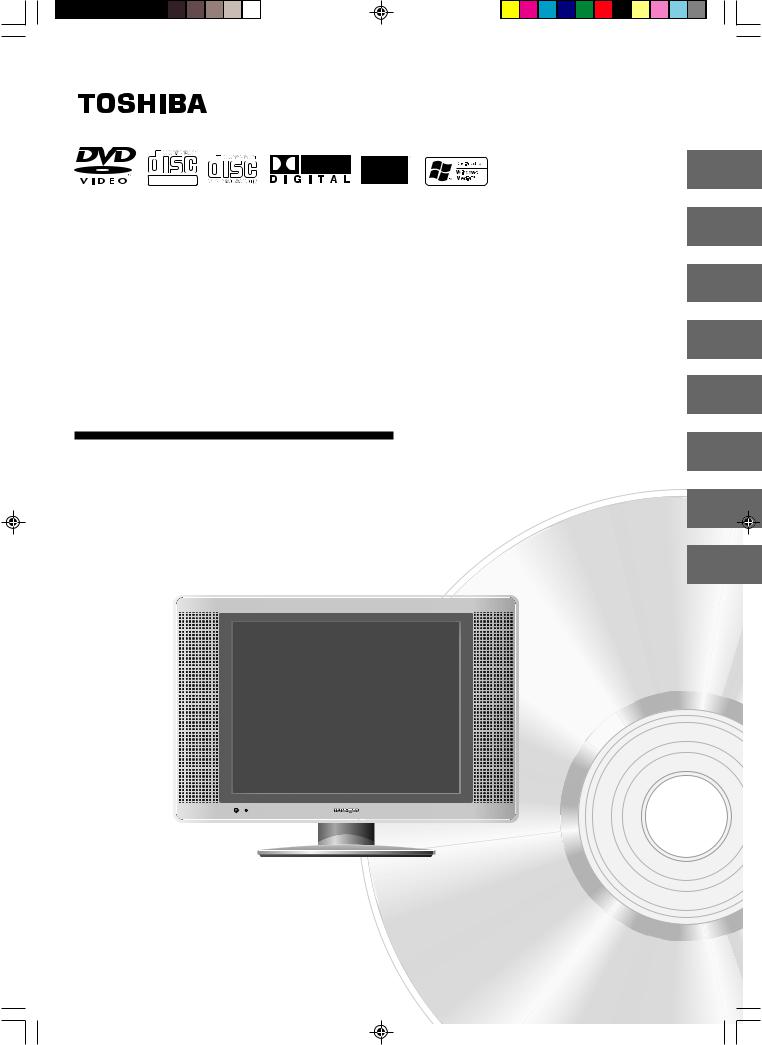
DIGITAL VIDEO
14-inch LCD TV/DVD
COMBINATION
SD-P4000
OWNER’S MANUAL
©2004 Toshiba Corporation
Before operating the unit, please read this manual thoroughly.
Introduction
Connections
Basic setup
TV operation
Basic playback
Advanced playback
Function setup
Others
2
14
21
23
31
34
43
47
J5N00201A [E] (Cover) |
1 |
6/8/04, 6:31 PM |

Introduction
IMPORTANT SAFEGUARDS
CAUTION
RISK OF ELECTRIC SHOCK
DO NOT OPEN
The lightning flash with arrowhead symbol, within an equilateral triangle is intended to alert the user to the presence of uninsulated dangerous voltage within the product's
enclosure that may be of sufficient magnitude to constitute a risk of electric shock.
CAUTION: TO REDUCE THE RISK OF ELECTRIC SHOCK, DO NOT REMOVE COVER (OR BACK). NO USER-SERVICEABLE PARTS INSIDE. REFER SERVICING TO QUALIFIED SERVICE PERSONNEL.
The exclamation point within an equilateral triangle is intended to alert the user to the presence of important operating and maintenance (servicing) instructions in the literature accompanying the appliance.
WARNING:
CAUTION:
TO PREVENT FIRE OR SHOCK HAZARD, DO NOT EXPOSE THIS APPLIANCE TO RAIN OR MOISTURE.
TO PREVENT ELECTRIC SHOCK DO NOT USE THIS POLARIZED PLUG WITH AN EXTENSION CORD, RECEPTACLE OR OTHER OUTLET UNLESS THE BLADES CAN BE FULLY INSERTED TO PREVENT BLADE EXPOSURE.
WARNING: This equipment has been tested and found to comply with the limits for a Class B digital device, pursuant to Part 15 of the FCC Rules. These limits are designed to provide reasonable protection against harmful interference in a residential installation. This equipment generates, uses and can radiate radio frequency energy and, if not installed and used in accordance with the instructions, may cause harmful interference to radio communications.
However, there is no guarantee that interference will not occur in a particular installation. If this equipment does cause harmful interference to radio or television reception, which can be determined by turning the equipment off and on, the user is encouraged to try to correct the interference by one or more of the following measures:
-Reorient or relocate the receiving antenna.
-Increase the distance between the equipment and receiver.
-Connect the equipment into an outlet on a circuit different from that to which the receiver is connected.
-Consult the dealer or an experienced radio/TV technician for help.
CAUTION: Changes or modifications not expressly approved by the party responsible for compliance with the FCC (Federal Communications Commission) Rules could void the user's authority to operate this equipment.
COPYRIGHT: It is permissible to record television programs, films, video tapes and other material only in the event that third party copyrights and other rights are not violated.
CAUTION:
THIS DIGITAL VIDEO PLAYER EMPLOYS A LASER SYSTEM.
TO ENSURE PROPER USE OF THIS PRODUCT, PLEASE READ THIS OWNER'S MANUAL CAREFULLY AND RETAIN FOR FUTURE REFERENCE. SHOULD THE UNIT REQUIRE MAINTENANCE, CONTACT AN AUTHORIZED SERVICE LO- CATION-SEE SERVICE PROCEDURE.
USE OF CONTROLS, ADJUSTMENTS OR THE PERFORMANCE OF PROCEDURES OTHER THAN THOSE SPECIFIED HEREIN MAY RESULT IN HAZARDOUS RADIATION EXPOSURE.
TO PREVENT DIRECT EXPOSURE TO LASER BEAM, DO NOT TRY TO OPEN THE ENCLOSURE. VISIBLE LASER RADIATION MAY BE PRESENT WHEN THE ENCLOSURE IS OPENED. DO NOT STARE INTO BEAM.
Location of the required Marking
The rating sheet and the safety caution are on the rear of the unit.
CERTIFICATION: COMPLIES WITH FDA RADIATION PERFORMANCE STANDARDS, 21 CFR SUBCHAPTER J.
2
J5N00201A [E] (P02-05) |
2 |
6/8/04, 7:14 PM |
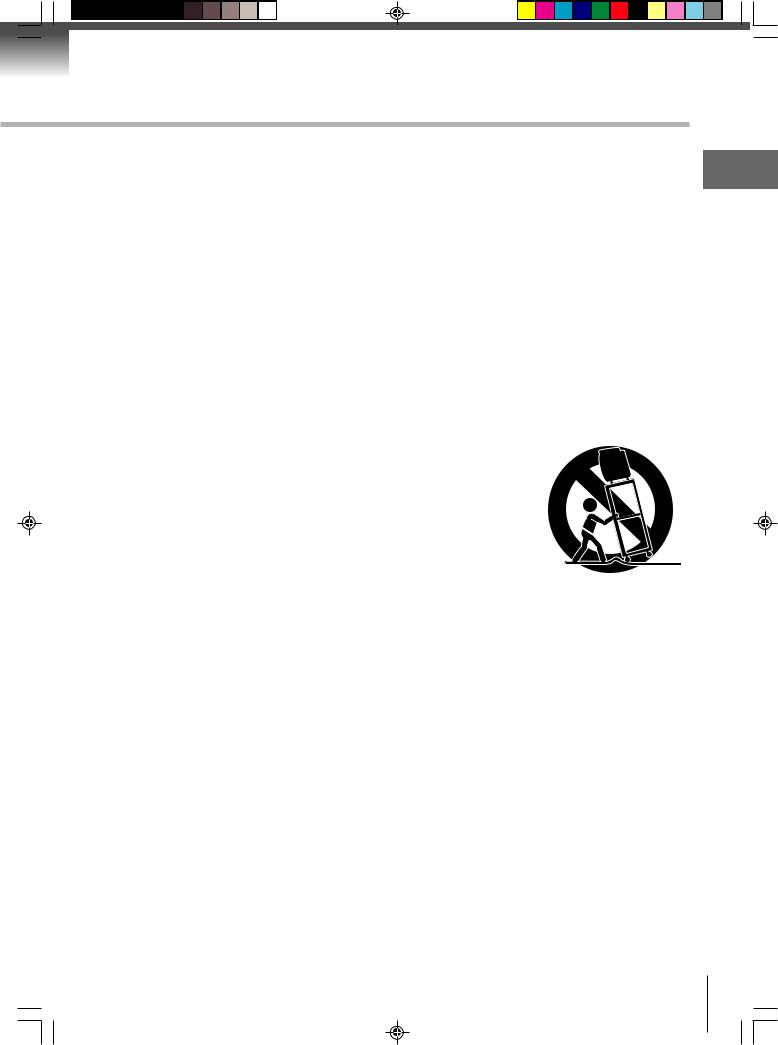
1.READ INSTRUCTIONS
All the safety and operating instructions should be read before the unit is operated.
2.RETAIN INSTRUCTIONS
The safety and operating instructions should be retained for future reference.
3.HEED WARNINGS
All warnings on the unit and in the operating instructions should be adhered to.
4.FOLLOW INSTRUCTIONS
All operating and use instructions should be followed.
5.CLEANING
Unplug this unit from the wall outlet before cleaning. Do not use liquid cleaners or aerosol cleaners. Use a damp cloth for cleaning the exterior cabinet only.
6.ATTACHMENTS
The manufacturer of this unit does not make any recommendations for attachments, as they may cause hazards.
7.WATER AND MOISTURE
Do not use this unit near water. For example, near a bathtub, washbowl, kitchen sink, laundry tub, in a wet
basement, or near a swimming pool.
8.ACCESSORIES
Do not place this unit on an unstable cart, stand, tripod, bracket, or table.
The unit may fall, causing serious injury, and serious damage to the unit.
8A. An appliance and cart combination should be moved with care. Quick stops, excessive force, and uneven surfaces may cause the appliance and cart combination to overturn.
9. VENTILATION
PORTABLE CART WARNING (symbol provided by RETAC)
Slots and openings in the cabinet back or bottom are provided for ventilation,
S3126A
and to ensure reliable operation of the unit, and to protect it from overheating.
These openings must not be blocked or covered. The openings should never be blocked by placing the unit on a bed, sofa, rug, or other similar surface. This unit should never be placed near or over a radiator or heat source. This unit should not be placed in a built-in installation such as a bookcase or rack unless proper ventilation is provided or the manufacturer’s instructions have been adhered to.
10.POWER SOURCE
This unit should be operated only from the type of power source indicated on the rating plate. If you are not sure of the type of power supply to your home, consult your appliance dealer or local power company. For units intended to operate from battery power, or other sources, refer to the respective pages on this Owner's Manual for their operating instructions.
11.GROUNDING OR POLARIZATION
This unit is equipped with a polarized alternating-current line plug (a plug having one blade wider than the other). This plug will fit into the power outlet only one way. This is a safety feature. If you are unable to insert the plug fully into the outlet, try reversing the plug. If the plug should still fail to fit, contact your electrician to replace your obsolete outlet. Instead of the polarized alternating-current line plug, your unit may be equipped with a 3-wire grounding-type plug (a plug having a third (grounding) pin). This plug will only fit into a grounding-type power outlet. This too, is a safety feature. If you are unable to insert the plug into the outlet, contact your electrician to replace your obsolete outlet.
Do not defeat the safety purpose of the grounding-type plug.
12.POWER-CORD PROTECTION
Power-supply cords should be routed so that they are not likely to be walked on or pinched by items placed upon or against them, paying particular attention to cords at plugs, convenience receptacles, and the point where they exit from the appliance.
Introduction
3
J5N00201A [E] (P02-05) |
3 |
6/8/04, 7:14 PM |
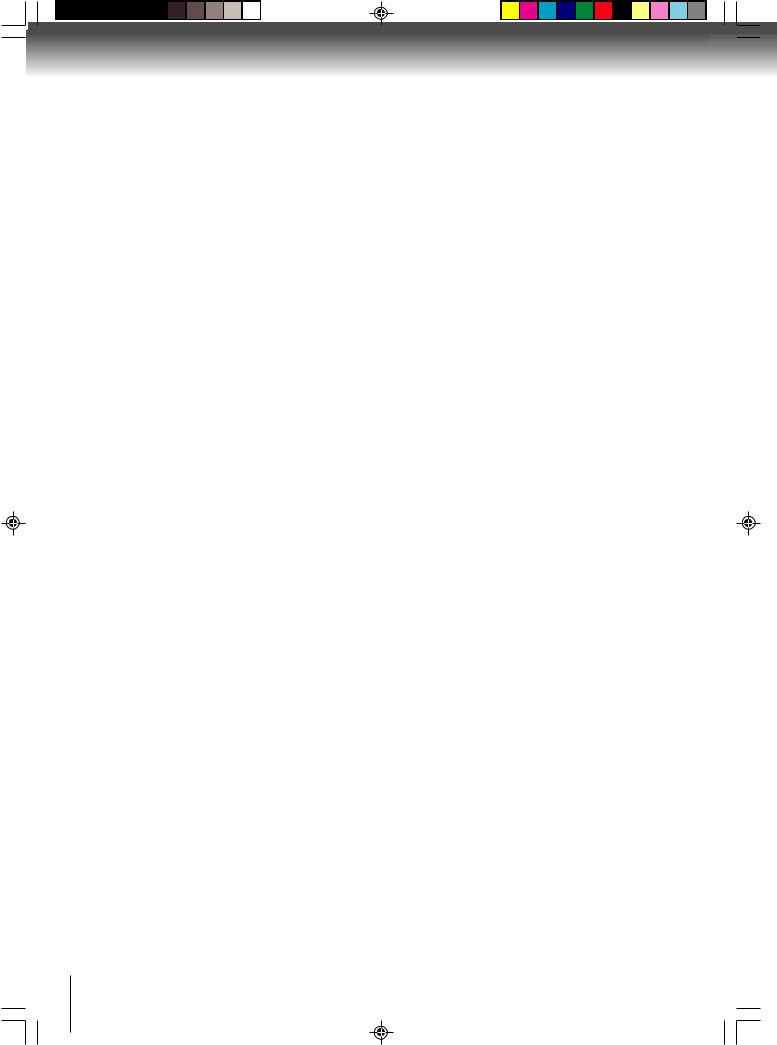
Introduction
IMPORTANT SAFEGUARDS |
(continued) |
||
|
|
|
|
13. |
LIGHTNING |
|
|
|
To protect your unit from a lightning storm, or when it is left unattended and unused for long periods of time, |
||
|
unplug it from the wall outlet and disconnect the antenna or cable system. This will prevent damage to the |
||
|
unit due to lightning and power line surges. |
|
|
14. |
POWER LINES |
|
|
|
An outside antenna system should not be located in the vicinity of overhead power lines or other electric |
||
|
light or power circuits, or where it can fall onto or against such power lines or circuits. When installing an |
||
|
outside antenna system, extreme care should be taken to keep from touching such power lines or circuits, |
||
|
as contact with them might be fatal. |
|
|
15. |
OVERLOADING |
|
|
|
Do not overload wall outlets and extension cords, as this can result in a risk of fire or electric shock. |
||
16. |
OBJECT AND LIQUID ENTRY |
|
|
|
Do not push objects through any openings in this unit, as they may touch dangerous voltage points or short |
||
|
out parts that could result in fire or electric shock. Never spill or spray any type of liquid into the unit. |
||
17. |
OUTDOOR ANTENNA GROUNDING |
|
|
|
If an outside antenna or cable system is connected to the unit, be sure the antenna or cable system is |
||
|
grounded to provide some protection against voltage surges and built-up static charges, Section 810 of the |
||
|
National Electrical Code (NEC), ANSI/NFPA 70, provides information with respect to proper grounding of |
||
|
the mast and supporting structure, grounding of the lead-in wire to an antenna discharge unit, size of |
||
|
grounding conductors, location of antenna discharge unit, connection to grounding electrodes, and require- |
||
|
ments for the grounding electrode. |
|
|
18. |
SERVICING |
|
|
|
Do not attempt to service this unit yourself as opening or removing covers may expose you to dangerous |
||
|
voltage or other hazards. Refer all servicing to qualified service personnel. |
|
|
|
For example: |
|
|
|
a. When the power-supply cord or plug is damaged. |
|
|
|
b. If liquid has been spilled, or objects have fallen into the unit. |
|
|
|
c. If the unit has been exposed to rain or water. |
|
|
|
d. If the unit does not operate normally by following the operating instructions. Adjust only those |
||
|
|
controls that are covered by the operating instructions, as an improper adjustment of other controls |
|
|
|
may result in damage and will often require extensive work by a qualified technician to restore the |
|
|
|
unit to its normal operation. |
|
|
e. |
If the unit has been dropped or the cabinet has been damaged. |
|
|
f. |
When the unit exhibits a distinct change in performance, this indicates a need for service. |
|
19. |
REPLACEMENT PARTS |
|
|
|
When replacement parts are required, be sure the service technician uses replacement parts specified by |
||
|
the manufacturer or those that have the same characteristics as the original part. |
|
|
|
Unauthorized substitutions may result in fire, electric shock or other hazards. |
|
|
20. |
SAFETY CHECK |
|
|
|
Upon completion of any service or repairs to this unit, ask the service technician to perform safety checks to |
||
|
determine that the unit is in proper operating condition. |
|
|
21. |
HEAT |
|
|
|
The product should be situated away from heat sources such as radiators, heat registers, stoves, or other |
||
|
products (including amplifiers) that produce heat. |
|
|
22. |
DISC SLOT |
|
|
|
Keep your fingers well clear of the disc slot as it is closing. It may cause serious personal injury. |
||
23. |
CONNECTING |
|
|
|
When you connect the product to other equipment, turn off the power and unplug all of the equipment from |
||
|
the wall outlet. Failure to do so may cause an electric shock and serious personal injury. Read the owner's |
||
|
manual of the other equipment carefully and follow the instructions when making any connections. |
||
24. |
SOUND VOLUME |
|
|
|
Reduce the volume to the minimum level before you turn on the product. Otherwise, sudden high volume |
||
|
sound may cause hearing or speaker damage. |
|
|
25. |
SOUND DISTORTION |
|
|
|
Do not allow the product output distorted sound for a longtime. It may cause speaker overheating and fire. |
||
26. |
HEADPHONES |
|
|
|
When you use the headphones, keep the volume at a moderate level. If you use the headphones continu- |
||
ously with high volume sound, it may cause hearing damage.
4
J5N00201A [E] (P02-05) |
4 |
6/8/04, 7:14 PM |
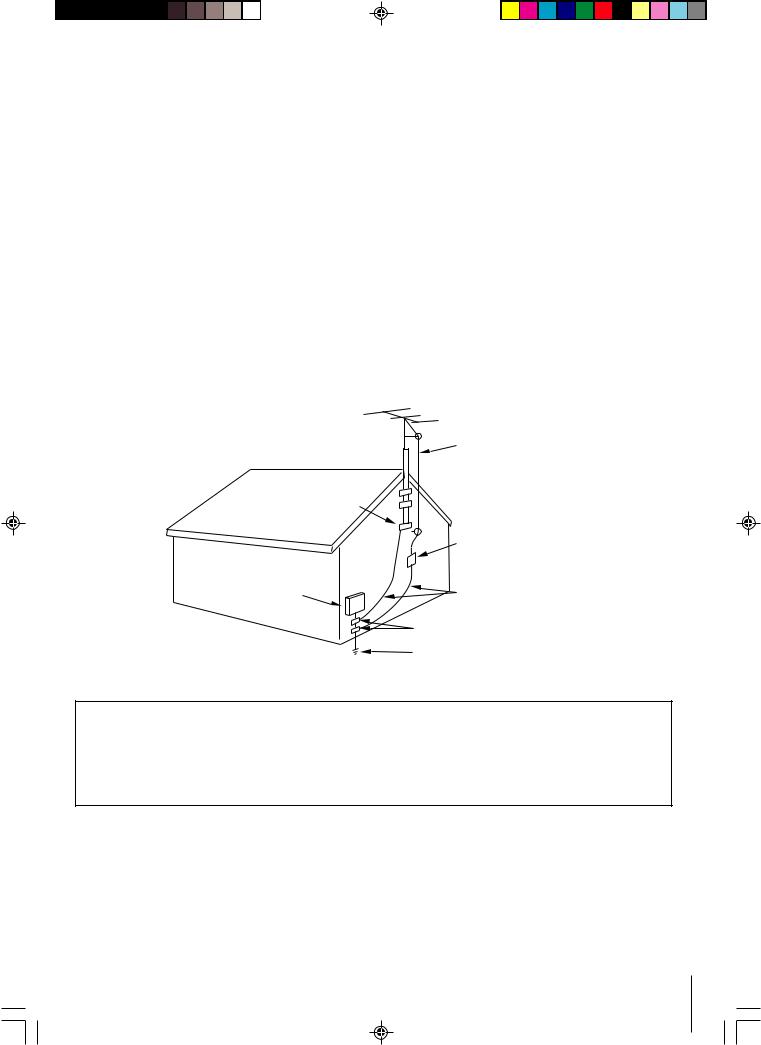
|
|
|
|
|
|
|
|
|
|
|
|
|
|
|
|
|
|
|
|
|
|
|
|
|
|
|
|
|
|
|
|
|
|
|
|
|
|
|
|
|
|
|
|
|
|
|
|
|
|
|
|
|
|
|
|
|
|
|
|
|
|
|
|
|
|
|
|
|
|
|
|
|
|
|
|
|
|
|
|
|
|
|
|
|
|
|
|
|
|
|
|
|
|
|
|
|
|
|
|
27. LASER BEAM |
|
|
|
|
|
|
|
|
|
|
|
|
|
|
|
Do not look into the opening of the disc slot or ventilation opening of the product to see the source of the |
|
|
|
|
|
||||||
|
|
|
|
|
|
|
|
|
|||||||
|
|
|
|
laser beam. It may cause sight damage. |
|
|
|
|
|
|
|
|
|
|
|
|
|
|
|
28. DISC |
|
|
|
|
|
|
|
|
|
|
|
|
|
|
|
Do not use a cracked, deformed, or repaired disc. These discs are easily broken and may cause serious |
Introduction |
|
|
|
|||||||
|
|
|
|
poisoning. If you have got it into your mouth, wash it out and consult your doctor. If your hands or clothes |
|
|
|
||||||||
|
|
|
|
personal injury and product malfunction. |
|
|
|
|
|
|
|
|
|
|
|
|
|
|
|
29. LCD |
|
|
|
|
|
|
|
|
|
|
|
|
|
|
|
Should the LCD panel be broken and liquid leaks out, do not inhale or swallow it. Doing so may cause |
|
|
|
|
|
||||||
|
|
|
|
have touched it, wipe them with alcohol and a cleaning cloth and then wash them well. |
|
|
|
|
|
||||||
|
|
|
|
30. NOTE TO CABLE TV SYSTEM INSTALLER |
|
|
|
|
|
|
|
|
|
|
|
|
|
|
|
This reminder is provided to call the Cable TV system installer’s attention to Article 820-40 of the NEC that |
|
|
|
|
|
||||||
|
|
|
|
provides guidelines for proper grounding and, in particular, specifies that the cable ground shall be con- |
|
|
|
|
|
||||||
|
|
|
|
nected to the grounding system of the building, as close to the point of cable entry as practical. |
|
|
|
|
|
||||||
|
|
|
|
EXAMPLE OF ANTENNA GROUNDING AS PER THE |
|
|
|
|
|
||||||
|
|
|
|
NATIONAL ELECTRICAL CODE |
|
|
|
|
|
||||||
|
|
|
|
|
|
|
|
|
ANTENNA LEAD |
|
|
|
|
|
|
|
|
|
|
|
|
|
|
|
IN WIRE |
|
|
|
|
|
|
|
|
|
|
GROUND |
|
|
|
|
|
|
|
|
|
|
|
|
|
|
|
CLAMP |
|
|
|
|
|
|
|
|
|
|
|
|
|
|
|
|
|
|
|
|
ANTENNA |
|
|
|
|
|
|
|
|
|
|
|
|
|
|
|
DISCHARGE UNIT |
|
|
|
|
|
|
|
|
|
|
|
|
|
|
|
(NEC SECTION 810-20) |
|
|
|
|
|
|
|
|
|
|
ELECTRIC SERVICE |
|
|
|
GROUNDING CONDUCTORS |
|
|
|
|
|
||
|
|
|
|
|
|
|
|
|
|
|
|
||||
|
|
|
|
EQUIPMENT |
|
|
|
(NEC SECTION 810-21) |
|
|
|
|
|
||
|
|
|
|
|
|
|
GROUND CLAMPS |
|
|
|
|
|
|||
|
|
|
|
|
|
|
|
|
|
|
|
||||
|
|
|
|
|
|
|
|
|
|
|
|
||||
|
|
|
|
NEC-NATIONAL ELECTRICAL CODE |
|
|
POWER SERVICE GROUNDING |
|
|
|
|
|
|||
|
|
|
|
|
|
ELECTRODE SYSTEM |
|
|
|
|
|
||||
|
|
|
|
|
|
|
|
|
|
|
|
||||
|
|
|
|
S2898A |
|
(NEC ART 250, PART H) |
|
|
|
|
|
||||
ON DISPOSAL
This product contains mercury. Disposal of mercury may be regulated due to environmental considerations. For disposal or recycling information, please contact your local authorities or the Electronic Industrial Alliance : www.eiae.org.
WARNING:
Handling the cord on this product or cords associated with accessories sold with this product will expose you to lead, a chemical known to the State of California to cause birth defects or other reproductive harm. Wash hands after handling.
5
J5N00201A [E] (P02-05) |
5 |
6/8/04, 7:14 PM |
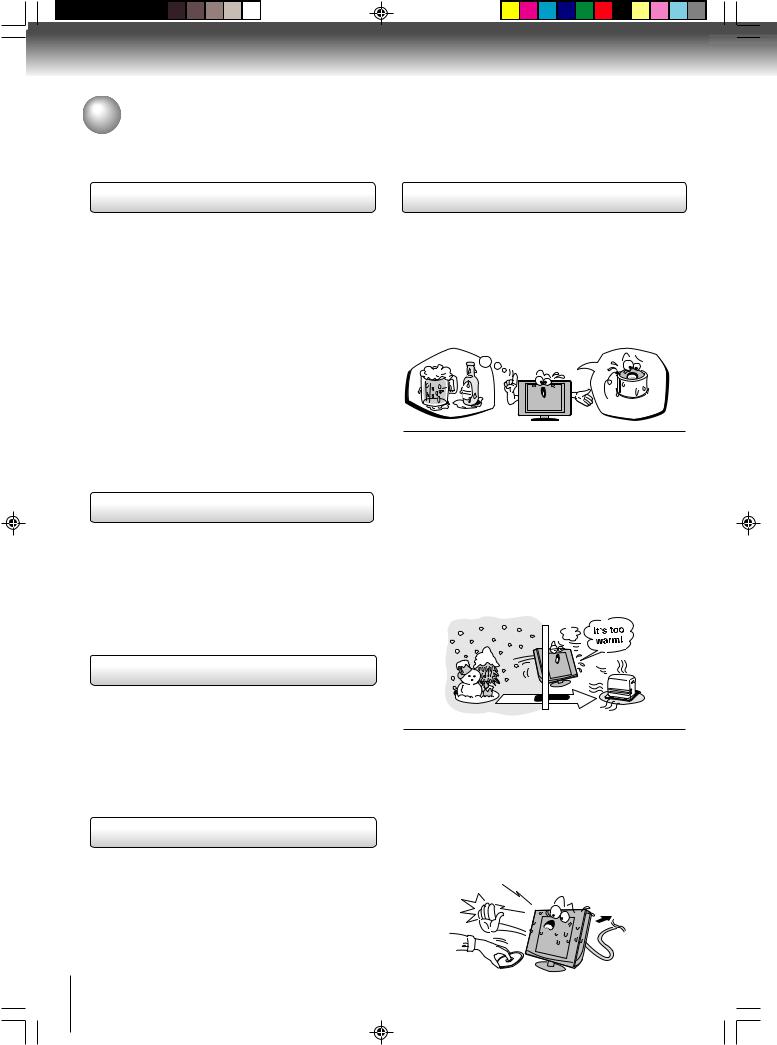
Introduction
Precautions
Notes on handling
Do not shock the LCD panel. It may cause unit damage and malfunction.
Do not press hard or jolt the LCD panel. It may cause the LCD panel glass to break and injury may occur.
When shipping the unit, the original shipping carton and packing materials come in handy. For maximum protection, repack the unit as it was originally packed at the factory.
Do not use volatile liquids, such as insect spray, near the unit. Do not leave rubber or plastic products to contact the unit for prolonged period. They will leave marks on the finish.
The top and rear panels of the unit may become warm after a long period of use. This is not a malfunction.
When the unit is not in use, be sure to remove the disc and turn off the power.
If you do not use the unit for a long period, the unit may not function properly in the future. Turn on and use the unit occasionally.
Notes on locating
Place the unit on a level surface. Do not use it on a shaky or unstable surface such as a wobbling table or inclined stand. The loaded disc may become disaligned and damage the unit.
When you place this unit near a TV, radio, or VCR, the playback picture may become poor and the sound may be distorted. In this case, place the unit away from the TV, radio, or VCR.
Notes on cleaning
Use a soft, dry cloth for cleaning.
 For stubborn dirt, soak the cloth in a weak detergent solution, wring well and wipe. Use a dry cloth to wipe it dry.
For stubborn dirt, soak the cloth in a weak detergent solution, wring well and wipe. Use a dry cloth to wipe it dry.
Do not use any type of solvent, such as thinner and benzine, as they may damage the surface of the unit.  If you use a chemical saturated cloth to clean the unit, follow that product’s instructions.
If you use a chemical saturated cloth to clean the unit, follow that product’s instructions.
To obtain a clear picture
The unit is a high technology, precision device. If the optical pick-up lens and disc drive parts are dirty or worn down, the picture quality will deteriorate. To obtain a clear picture, we recommend regular inspection and maintenance (cleaning or parts replacement) every 1,000 hours of use depending on the operating environment. For details, contact your nearest dealer.
6
Notes on moisture condensation
Moisture condensation damages the unit. Please read the following carefully.
Moisture condensation occurs, for example, when you pour a cold drink into a glass on a warm day. Drops of water form on the outside of the glass. In the same way, moisture may condense on the optical pick-up lens inside this unit, one of the most crucial internal parts of the unit.
|
|
|
le of m |
ois |
|
|
mp |
tu |
|||
a |
|
|
|
||
Ex |
|
|
e |
|
re |
|
|
ond nsatio |
|
||
|
c |
|
n! |
||
|
|
|
|
|
Optical pick-up |
|
|
|
|
|
lens |
Moisture condensation occurs during the following cases.
 When you bring the unit directly from a cold place to a warm place.
When you bring the unit directly from a cold place to a warm place.
 When you use the unit in a room where you just turned on the heater, or a place where the cold wind from the air conditioner directly hits the unit.
When you use the unit in a room where you just turned on the heater, or a place where the cold wind from the air conditioner directly hits the unit.
 In summer, when you use the unit in a hot and humid place just after you move the unit from an air conditioned room.
In summer, when you use the unit in a hot and humid place just after you move the unit from an air conditioned room.
 When you use the unit in a humid place.
When you use the unit in a humid place.
Do not use the unit when moisture condensation may occur.
If you use the unit in such a situation, it may damage discs and internal parts. Remove the disc, connect the power cord of the unit to the wall outlet, turn on the unit, and leave it for two or three hours. After two or three hours, the unit will have warmed up and evaporated any moisture. Keep the unit connected to the wall outlet and moisture condensation will seldom occur.
Wait!
Wall outlet
J5N00201A [E] (P06-07) |
6 |
6/8/04, 7:41 PM |
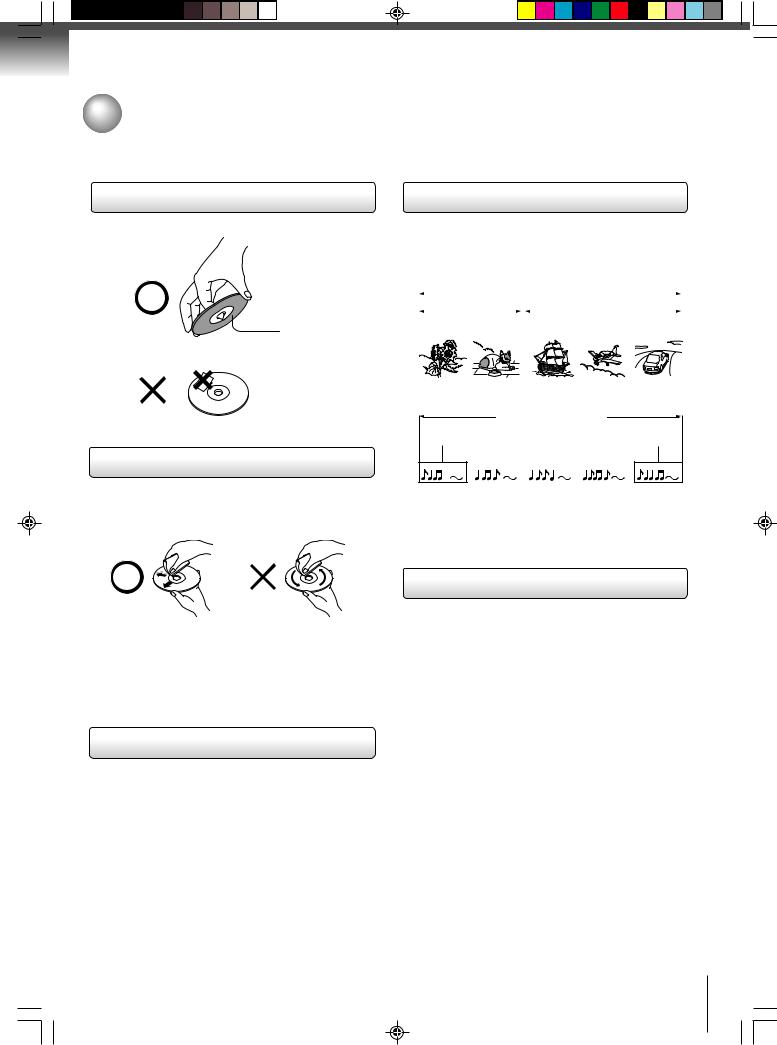
 Notes on discs
Notes on discs
On handling discs
 Do not touch the playback side of the disc.
Do not touch the playback side of the disc.
Playback side
 Do not attach paper or tape to discs.
Do not attach paper or tape to discs.
On cleaning discs
 Fingerprints and dust on the disc cause picture and sound deterioration. Wipe the disc from the center outwards with a soft cloth. Always keep the disc clean.
Fingerprints and dust on the disc cause picture and sound deterioration. Wipe the disc from the center outwards with a soft cloth. Always keep the disc clean.
 If you cannot wipe off the dust with a soft cloth, wipe the disc lightly with a slightly moistened soft cloth and finish with a dry cloth.
If you cannot wipe off the dust with a soft cloth, wipe the disc lightly with a slightly moistened soft cloth and finish with a dry cloth.
 Do not use any type of solvent such as thinner, benzine, commercially available cleaners or antistatic spray for vinyl LPs. It may damage the disc.
Do not use any type of solvent such as thinner, benzine, commercially available cleaners or antistatic spray for vinyl LPs. It may damage the disc.
On storing discs
 Do not store discs in a place subject to direct sunlight or near heat sources.
Do not store discs in a place subject to direct sunlight or near heat sources.
 Do not store discs in places subject to moisture and dust such as a bathroom or near a humidifier.
Do not store discs in places subject to moisture and dust such as a bathroom or near a humidifier.  Store discs vertically in a case. Stacking or placing objects on discs outside of their case may cause warping.
Store discs vertically in a case. Stacking or placing objects on discs outside of their case may cause warping.
Structure of disc contents |
|
||||||||||||||||||||||||||||||
Introduction |
|||||||||||||||||||||||||||||||
Audio CDs are divided into tracks. |
|
|
|
|
|
|
|
|
|
|
|||||||||||||||||||||
Normally, DVD video discs are divided into titles, and |
|
||||||||||||||||||||||||||||||
the titles are sub-divided into chapters. Video CDs and |
|
||||||||||||||||||||||||||||||
DVD video disc |
|
|
|
|
|
|
|
|
|
|
|
||||||||||||||||||||
|
|
|
|
|
|
|
|
|
|
DVD video disc |
|
|
|
|
|
|
|
|
|
||||||||||||
|
|
|
|
Title 1 |
|
|
|
|
|
|
|
|
|
|
|
|
|
Title 2 |
|
|
|
|
|
|
|
||||||
|
|
Chapter |
|
|
|
|
|
Chapter 1 |
|
|
|
||||||||||||||||||||
|
|
|
|
|
|
|
|
|
|
|
|
|
|||||||||||||||||||
|
|
1 Chapter 2 |
|
|
Chapter 2 Chapter 3 |
|
|
||||||||||||||||||||||||
|
|
|
|
|
|
|
|
|
|
|
|
|
|
|
|
|
|
|
|
|
|
|
|
|
|
|
|
|
|
|
|
|
|
|
|
|
|
|
|
|
|
|
|
|
|
|
|
|
|
|
|
|
|
|
|
|
|
|
|
|
|
|
|
|
|
|
|
|
|
|
|
|
|
|
|
|
|
|
|
|
|
|
|
|
|
|
|
|
|
|
|
|
|
|
|
|
|
|
|
|
|
|
|
|
|
|
|
|
|
|
|
|
|
|
|
|
|
|
|
|
|
|
|
|
|
|
|
|
|
|
|
|
|
|
|
|
|
|
|
|
|
|
|
|
|
|
|
|
|
|
|
|
|
|
|
|
|
|
|
Video CD/Audio CD
Video CD/Audio CD
Track 1 |
Track 2 |
Track 3 |
Track 4 |
Track 5 |
|||||
|
|
|
|
|
|
|
|
|
|
|
|
|
|
|
|
|
|
|
|
Each title, chapter or track is assigned a number, which is called “title number”, “chapter number” or “track number” respectively.
There may be discs that do not have these numbers.
Notes on copyright
It is forbidden by law to copy, broadcast, show, broadcast on cable, play in public, and rent copyrighted material without permission.
DVD video discs are copy protected, and any recordings made from these discs will be distorted.
This product incorporates copyright protection technology that is protected by method claims of certain U.S. patents and other intellectual property rights owned by Macrovision Corporation and other rights owners. Use of this copyright protection technology must be authorized by Macrovision Corporation, and is intended for home and other limited viewing uses only unless otherwise authorized by Macrovision Corporation. Reverse engineering or disassembly is prohibited.
7
J5N00201A [E] (P06-07) |
7 |
6/8/04, 7:23 PM |
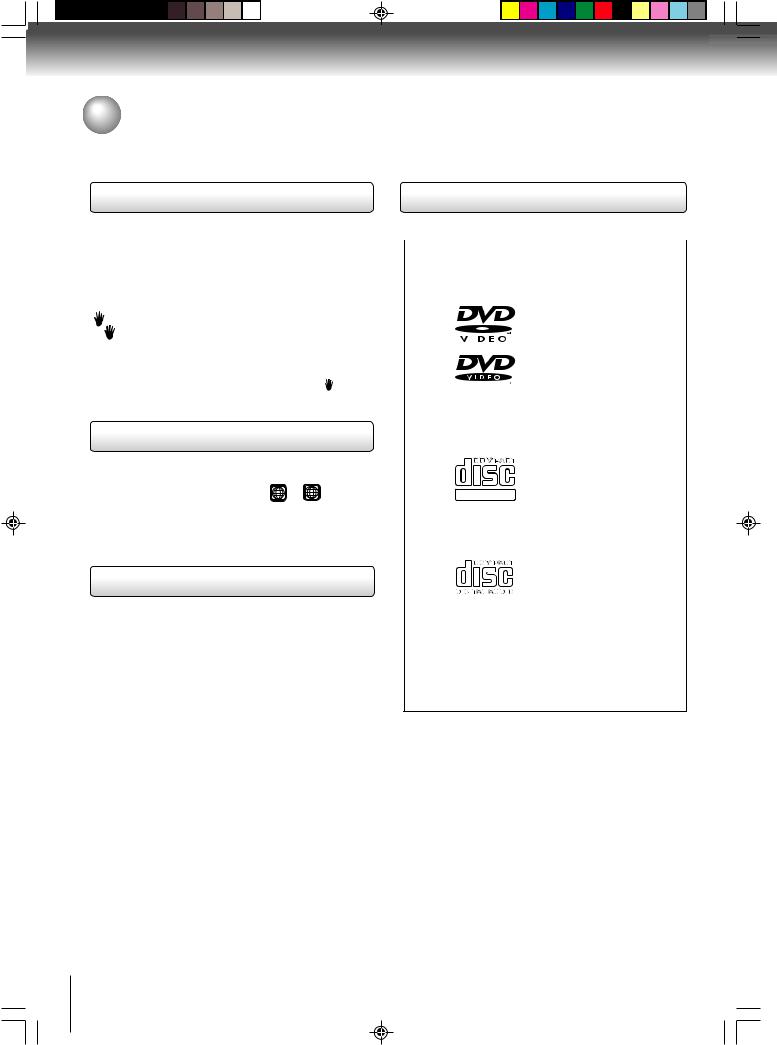
Introduction
Notes on discs (continued)
About this owner’s manual
This owner’s manual explains the basic instructions of this unit. Some DVD video discs are produced in a manner that allows specific or limited operation during playback. As such, the unit may not respond to all operating commands. This is not a defect in the unit. Refer to instruction notes of discs.
“ ” may appear on the TV screen during operation. A “ ” means that the operation is not permitted by the unit or the disc.
For example, sometimes it is unable to stop the playback of copyright message of the disc when the STOP () button is pressed. Alternatively, the “ ” may also indicate that the feature is not available for the disc.
Notes on region numbers
The region number of this unit is 1. If region numbers, which stand for their playable area, are printed on your DVD video disc and you do not find 1 or ALL , disc
playback will not be allowed by the player. (In this case, the unit will display a message on-screen.)
Some DVDs that have no region code label may still be subject to area restrictions and therefore not playable.
On Video CDs
This DVD supports Video CDs equipped with the PBC (Version 2.0) function. (PBC is the abbreviation of Playback Control.) You can enjoy two playback variations depending on types of discs.
•Video CD not equipped with PBC function (Version 1.1)
Sound and movie can be played on this DVD in the same way as an audio CD.
•Video CD equipped with PBC function (Version 2.0)
In addition to operation of a Video CD not equipped with the PBC function, you can enjoy playback of interactive software with search function by using the menu displayed on the TV screen (Menu Playback). Some of the functions described in this owner’s manual may not work with some discs.
Playable discs
This unit can play the following discs.
|
Disc Mark |
Contents |
Disc |
Maximum |
|
|
Size |
playback time |
|||
|
|
|
|
||
|
|
|
|
|
|
|
|
|
|
|
Approx. 4 hours |
|
|
|
|
|
(single sided disc) |
|
|
|
Audio |
12 cm |
|
|
|
|
Approx. 8 hours |
||
|
|
|
|
||
|
|
|
+ |
|
|
DVD |
|
|
|
(double sided disc) |
|
|
|
Video |
|
||
video |
|
|
|
|
|
|
|
|
|
||
|
|
(moving |
|
|
|
discs |
|
|
|
Approx. 80 minutes |
|
|
|
pictures) |
|
||
|
|
|
|
|
(single sided disc) |
|
|
|
|
8 cm |
|
|
|
|
|
Approx. 160 minutes |
|
|
|
|
|
|
|
|
|
|
|
|
(double sided disc) |
|
|
|
|
|
|
|
|
|
Audio |
12 cm |
Approx. 74 minutes |
|
|
|
|
|
|
Video |
|
|
+ |
|
|
|
|
Video |
|
|
|
CDs |
|
|
|
|
|
DIGITAL VIDEO |
(moving |
|
|
||
|
|
|
|||
|
pictures) |
|
|
||
|
|
|
8 cm |
Approx. 20 minutes |
|
|
|
|
|
||
|
|
|
|
|
|
|
|
|
|
12 cm |
Approx. 74 minutes |
Audio |
|
|
Audio |
|
|
CDs |
|
|
8 cm |
|
|
|
|
|
|
||
|
|
|
|
(CD |
Approx. 20 minutes |
|
|
|
|
single) |
|
|
|
|
|
|
|
The following discs are also available.  DVD-R/RW discs of DVD video format
DVD-R/RW discs of DVD video format
 CD-R/CD-RW discs of CD-DA, Video CD, MP3, WMA or JPEG format
CD-R/CD-RW discs of CD-DA, Video CD, MP3, WMA or JPEG format
 Kodak Picture CD and FUJICOLOR CD format Some of these discs may be incompatible.
Kodak Picture CD and FUJICOLOR CD format Some of these discs may be incompatible.
•You cannot play discs other than those listed above.
•You cannot play discs of DVD-RAM, DVD-ROM, Photo CD, etc., or non standardized discs even if they may be labeled as above.
•Some CD-R/RWs cannot be played back depending on the recording conditions.
•This unit uses the NTSC color system, and cannot play DVD video discs recorded in any other color system (PAL, SECAM, etc.).
8
J5N00201A [E] (P08-13) |
8 |
6/8/04, 7:15 PM |
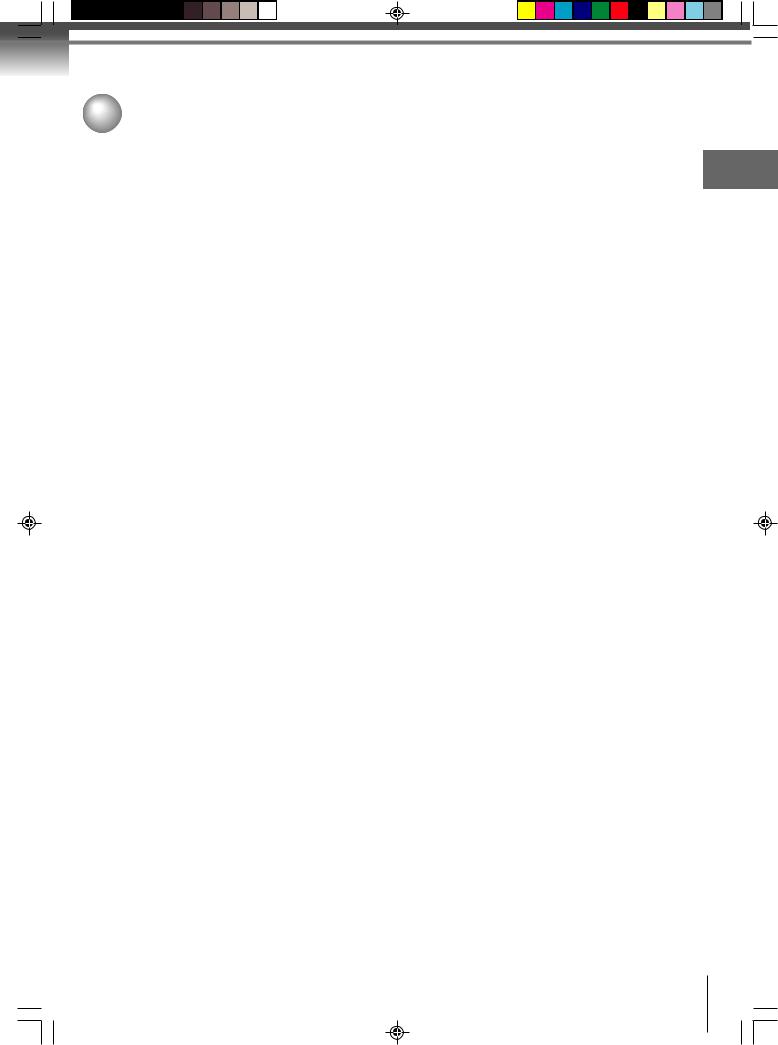
Contents |
|
Introduction |
|
IMPORTANT SAFEGUARDS ............................ |
2 |
Precautions ....................................................... |
6 |
Notes on discs ................................................... |
7 |
Contents ............................................................ |
9 |
Identification of controls .................................. |
10 |
Connections |
|
Antenna connections ....................................... |
14 |
Cable TV connections ..................................... |
15 |
Connecting to optional equipment................... |
16 |
Power source .................................................. |
20 |
Basic setup |
|
Setting the language ....................................... |
21 |
To memorize channels .................................... |
22 |
TV operation |
|
TV operation .................................................... |
23 |
Closed captions ............................................... |
25 |
Setting the V-Chip ........................................... |
26 |
Picture control adjustment ............................... |
28 |
Adjusting the picture preference ..................... |
28 |
Selecting the color temperature ...................... |
29 |
Sound control adjustment ............................... |
30 |
Stereo and Second Audio Program (SAP) ...... |
30 |
Basic playback |
|
Playing a disc .................................................. |
31 |
Advanced playback |
|
Zooming ......................................................... |
34 |
Locating desired scene .................................. |
34 |
Repeat playback ............................................ |
35 |
A-B Repeat playback ..................................... |
35 |
Program playback .......................................... |
36 |
Random playback .......................................... |
36 |
Changing angles ............................................ |
37 |
Title selection ................................................. |
37 |
DVD menu...................................................... |
37 |
Changing soundtrack language ..................... |
38 |
Subtitles ......................................................... |
38 |
Karaoke playback........................................... |
39 |
Disc status...................................................... |
39 |
To turn off the PBC ........................................ |
39 |
MP3/WMA/JPEG CD operation ..................... |
40 |
Function setup |
|
Customizing the function settings .................. |
43 |
Temporary disabling of rating level |
|
by DVD disc ................................................... |
46 |
Others |
|
Language code list ......................................... |
47 |
Troubleshooting ............................................. |
48 |
Reception disturbances .................................. |
50 |
Specifications ................................................. |
51 |
Limited United States warranty ...................... |
52 |
Introduction
9
J5N00201A [E] (P08-13) |
9 |
6/8/04, 7:15 PM |
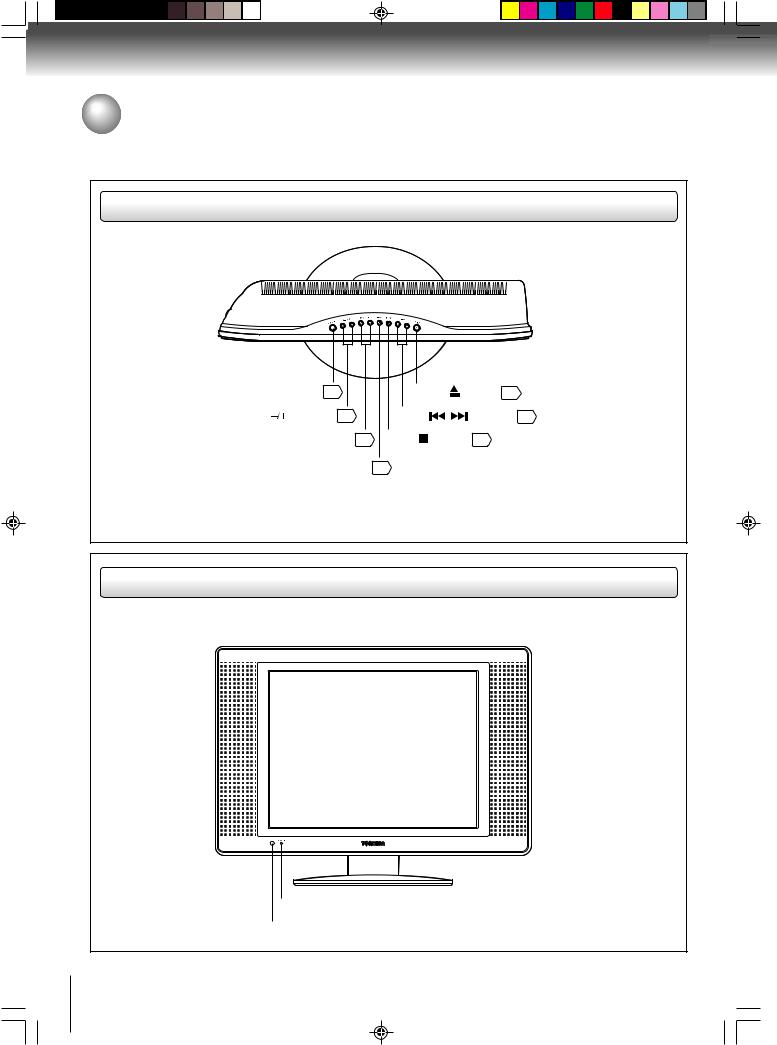
Introduction
Identification of controls
See the page in  for details.
for details.
Top
POWER button 21 |
EJECT ( |
) button 32 |
|
VOLUME ( ) buttons 23 |
SKIP ( |
/ |
) buttons 33 |
CHANNEL (4/3) buttons 22 |
STOP( |
) button 31 |
|
PLAY ( ) button 31
) button 31
Front
POWER indicator
Remote sensor
10
J5N00201A [E] (P08-13) |
10 |
6/8/04, 7:16 PM |
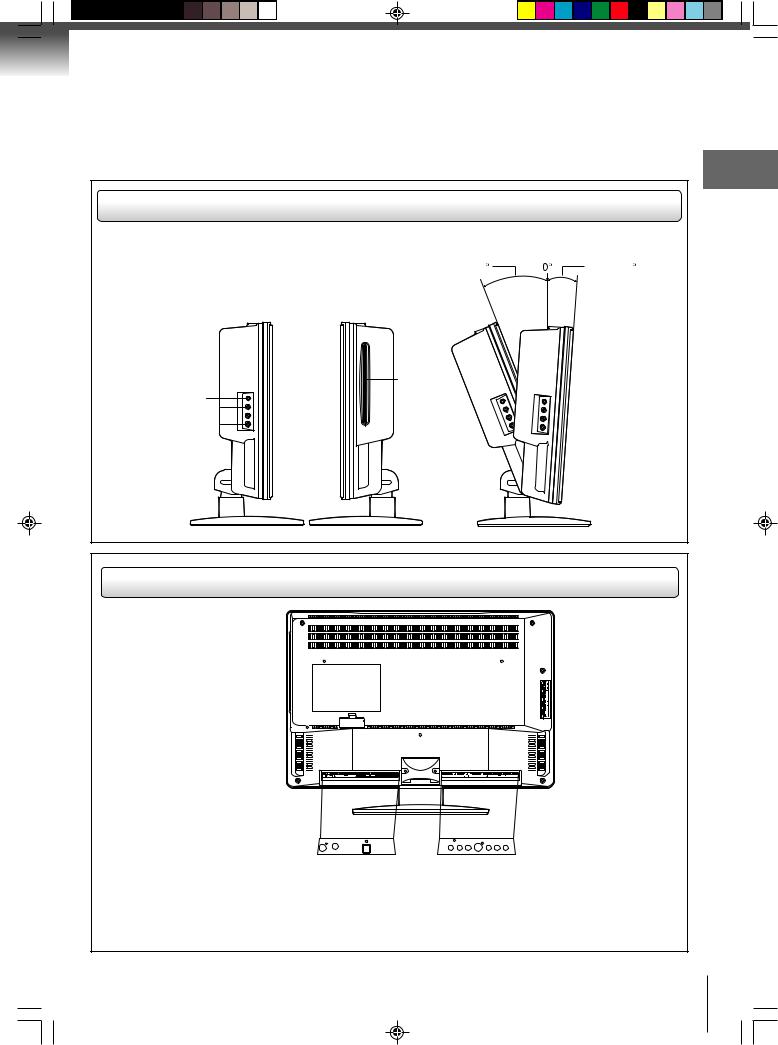
Side
Left Side
PHONES jack
VIDEO IN/AUDIO IN  (L/R) (LINE 2 IN) jacks
(L/R) (LINE 2 IN) jacks
Right Side
Disc slot
Adjusting the angle of the base
Approx. 15 |
Approx. 5 |
You can adjust the angle of the TVscreen for 5° forward or for 15° backward from vertical angle.
Introduction
Rear
|
|
|
|
|
|
|
|
|
|
|
|
COAXIAL DIGITAL AUDIO OUT jack |
|
|
|
|
|
|
|
|
|
|
|
|
|
|
|
|
|
COMPONENT VIDEO IN |
|||||
RF IN jack |
|
|
|
|
|
(Y, PB/CB, PR/CR) jacks |
|||||
|
|
|
|
|
|
|
|
||||
|
DC input |
jack |
|
|
S-VIDEO (LINE 1 IN) jack |
||||||
|
|
|
|
VIDEO IN/AUDIO IN (L/R) (LINE 1 IN) jacks |
|||||||
11
J5N00201A [E] (P08-13) |
11 |
6/8/04, 7:16 PM |
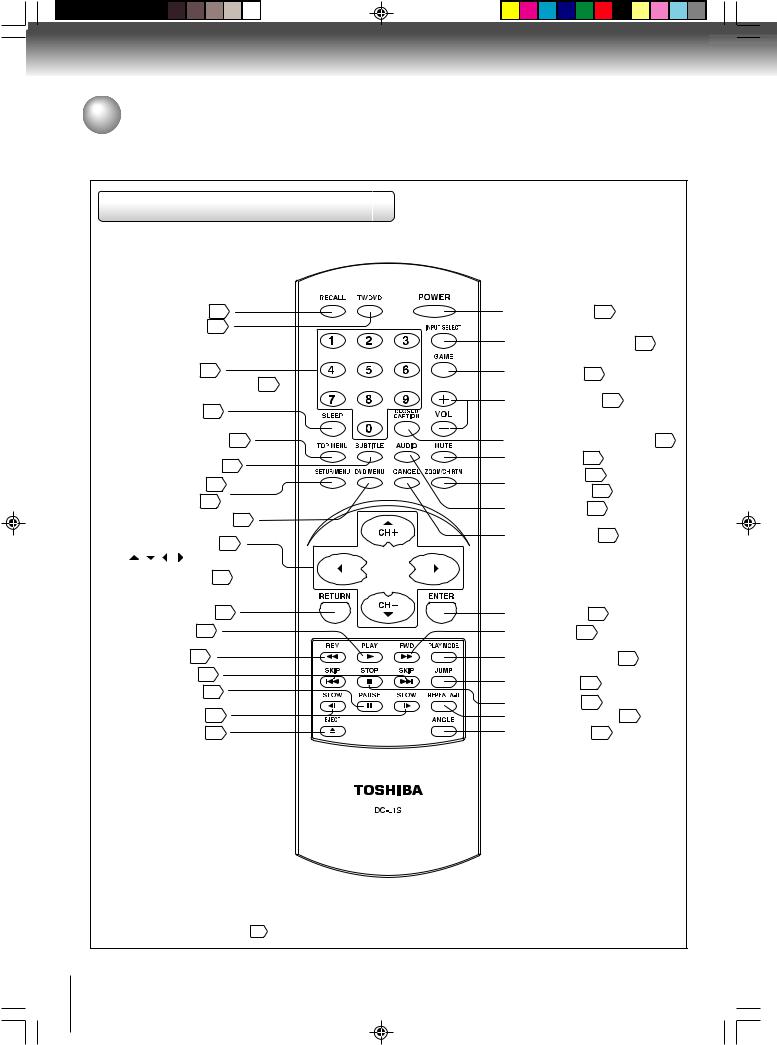
Introduction
Identification of controls (continued)
Remote control
The instructions in this manual describe the function on the remote control. See the page in  for details.
for details.
RECALL button 24
TV/DVD button 31
Direct channel selection buttons (0-9) 23 Numbered buttons (0-9) 26
SLEEP button 24
TOP MENU button 37
SUBTITLE button 38
SETUP button 43
MENU button 21
*DVD MENU button 37
Direction buttons |
21 |
( / / / ) |
|
CH +/- buttons |
22 |
RETURN button 43
PLAY button 31
REV button 33
SKIP buttons 33
PAUSE button 32
SLOW buttons 33
EJECT button 32
*DVD MENU button
Use the DVD MENU button to display the menu included on many DVD video discs.
To operate a menu, follow the instructions in “DVD menu.” 37
POWER button 21
INPUT SELECT button 16
GAME button 16
VOL +/- buttons 23
CLOSED CAPTION button 25 MUTE button 24
ZOOM button 34 CH RTN button 24
AUDIO button 30
CANCEL button 26
ENTER button 21
FWD button 33
PLAY MODE button 35
JUMP button 34
STOP button 31 REPEAT A-B button 35 ANGLE button 37
12
J5N00201A [E] (P08-13) |
12 |
6/8/04, 7:16 PM |
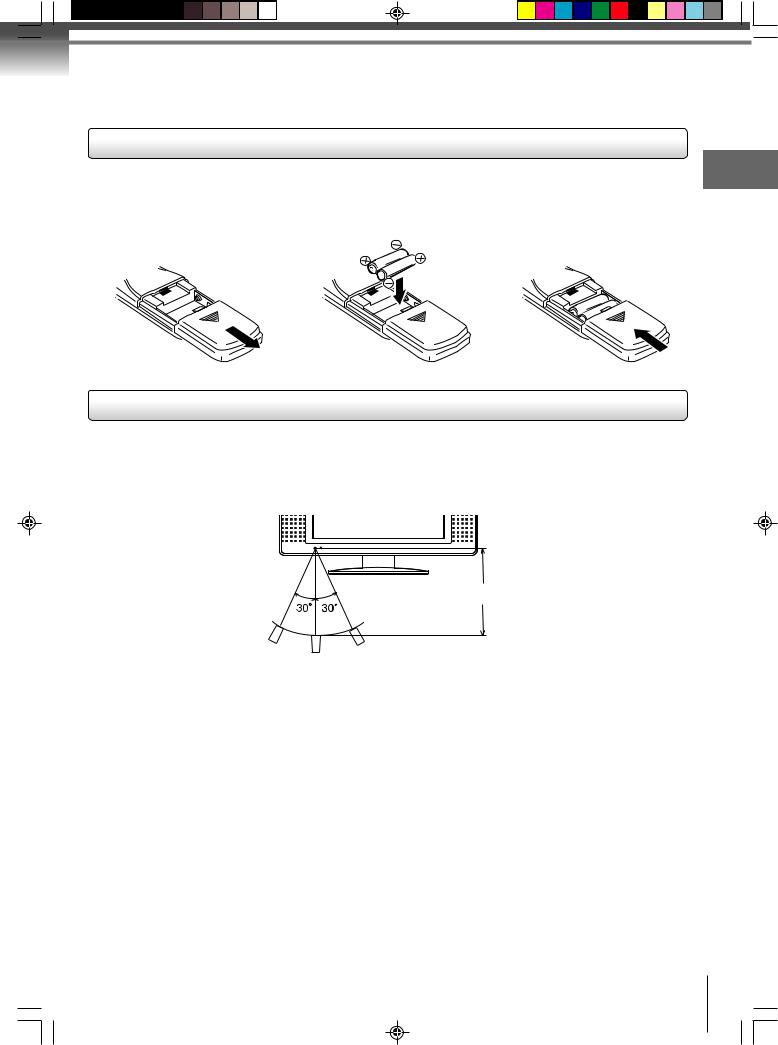
Inserting batteries
1 Slide the battery compartment |
2 Install two “R03/AAA” batteries |
3 Replace the compartment |
cover in the direction of the |
(supplied), paying attention to |
cover. |
arrow. |
the polarity diagram in the |
|
|
battery compartment. |
|
Operation
•Aim the remote control at the remote sensor and press control buttons to operate.
•Operate the remote control within 30° angle on either side of the remote sensor, up to a distance of approx. 5 meters.
Introduction
Approx. 5 meters
The precautions below should be followed when using batteries in this device:
1.Use only the size and type of batteries specified.
2.Be sure to follow the correct polarity when installing the batteries as indicated in the battery compartment. Reversed batteries may cause damage to the device.
3.Do not mix different types of batteries together (e.g. Alkaline and Carbon-zinc) or old batteries with fresh ones.
4.If the device is not to be used for a long period of time, remove the batteries to prevent damage or injury from possible battery leakage.
5.Do not try to recharge batteries not intended to be recharged; they can overheat and rupture (follow battery manufacturer’s directions).
13
J5N00201A [E] (P08-13) |
13 |
6/8/04, 7:16 PM |
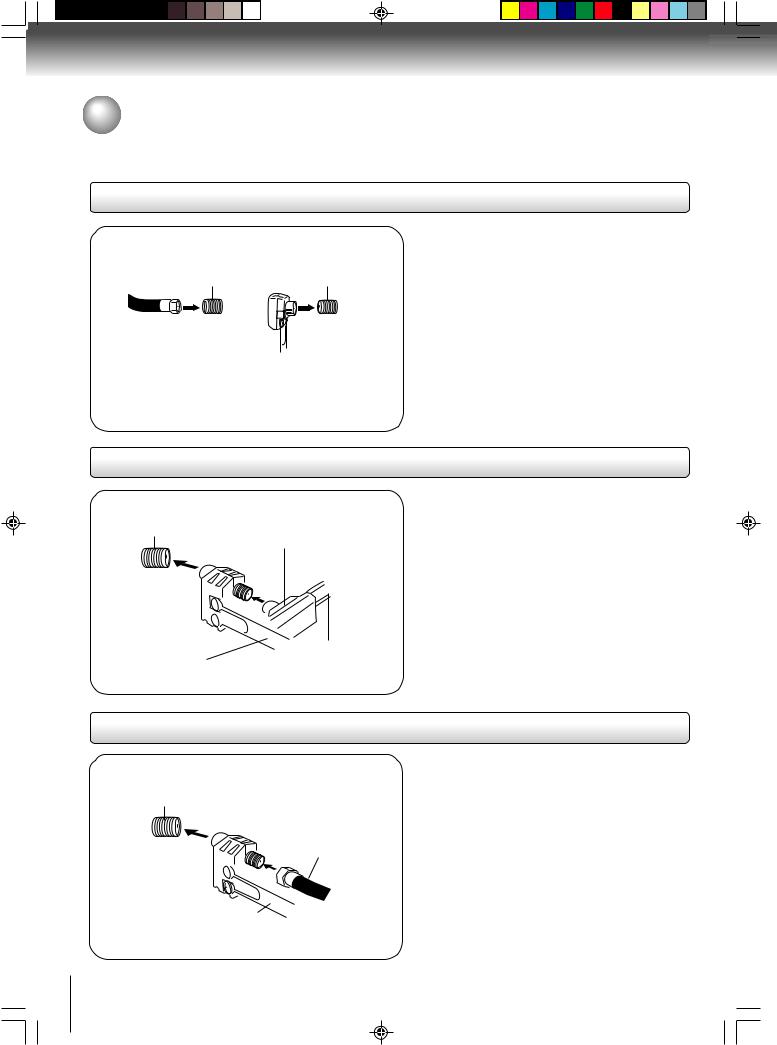
Connections
Antenna connections
If you are using an indoor or outdoor antenna, follow the instructions below that correspond to your antenna system. If you are using a cable TV service (CABLE), see page 15 for Cable TV connections.
Combination VHF/UHF antenna (Single 75 ohm cable or 300 ohm twin-lead wire)
Antenna |
Antenna |
jack |
jack |
75 ohm coaxial cable (not supplied)
300-75 ohm matching transformer (supplied)
Connect the 75 ohm cable from the combination VHF/UHF antenna to the antenna jack.
If your combination VHF/UHF antenna has a 300 ohm twin-lead wire, the use of the 300-75 ohm matching transformer may be necessary.
Combination VHF/UHF antenna (Separate VHF and UHF 300 ohm twin-lead wires)
Antenna
jack
Combiner 
 (not supplied)
(not supplied) 
UHF 300 ohm twin-lead wire
(not supplied)
300-75 ohm matching transformer (supplied)
VHF 300 ohm twin-lead wire (not supplied)
Connect the UHF 300 ohm twin-lead wire to the combiner (not supplied). Connect the VHF 300 ohm twin-lead wire to the 300-75 ohm matching transformer. Attach the transformer to the combiner, then attach the combiner to the antenna jack.
Separate VHF/UHF antennas (75 ohm VHF cable and 300 ohm UHF twin-lead wires)
Antenna
jack
VHF 75 ohm
(not supplied)
Combiner 
 (not supplied)
(not supplied)
UHF 300 ohm twin-lead wire
(not supplied)
Connect the VHF 75 ohm cable and UHF 300 ohm twin-lead wire to the combiner (not supplied). Attach the combiner to the antenna jack.
14
J5N00201A [E] (P14-25) |
14 |
6/8/04, 7:01 PM |

 Cable TV connections
Cable TV connections
This TV/DVD has an extended tuning range and can tune most cable channels without using a Cable TV converter box. Some cable companies offer “premium pay channels” in which the signal is scrambled. Descrambling these signals for normal viewing requires the use of a descrambler device which is generally provided by the cable company.
For subscribers to basic cable TV service
75 ohm coaxial cable
Antenna |
For basic cable service not requiring a converter/descrambler |
jack |
box, connect the Cable TV 75 ohm coaxial cable directly to the |
|
|
|
Antenna jack on the back of the TV/DVD. |
Connections
For subscribers to scrambled cable TV service
If you subscribe to a cable TV service which requires the use of a converter/descrambler box, connect the incoming 75 ohm coaxial cable to the converter/descrambler box. Using another 75 ohm coaxial cable, connect the output jack of the converter/descrambler box to the antenna jack on the TV/DVD. Follow the connections shown below. Set the TV/DVD to the output channel of the converter/descrambler box (usually channel 3 or 4) and use the converter/descrambler box to select channels.
Incoming |
|
|
Antenna |
75 ohm |
|
|
|
|
75 ohm cable to |
jack |
|
Cable TV |
Converter/ |
TV/DVD |
|
|
descrambler |
|
|
For subscribers to unscrambled basic cable TV service with scrambled premium channels
If you subscribe to a cable TV service in which basic channels are unscrambled and premium channels require the use of a converter/descrambler box, you may wish to use a signal splitter and an A/B Switch box (available from the cable company or an electronics supply store). Follow the connections shown below. With the switch in the “B” position, you can directly tune any nonscrambled channels on your TV/DVD. With the switch in the “A” position, tune your TV/DVD to the output of the converter/descrambler box (usually channel 3 or 4) and use the converter/ descrambler box to tune scrambled channels.
Incoming |
Converter/ |
|
|
descrambler |
75 ohm cable |
Antenna |
|
75 ohm |
|
||
|
jack |
||
Cable TV |
|
to TV/DVD |
|
Splitter |
A/B switch |
A |
|
|
|
B |
|
15
J5N00201A [E] (P14-25) |
15 |
6/8/04, 7:01 PM |
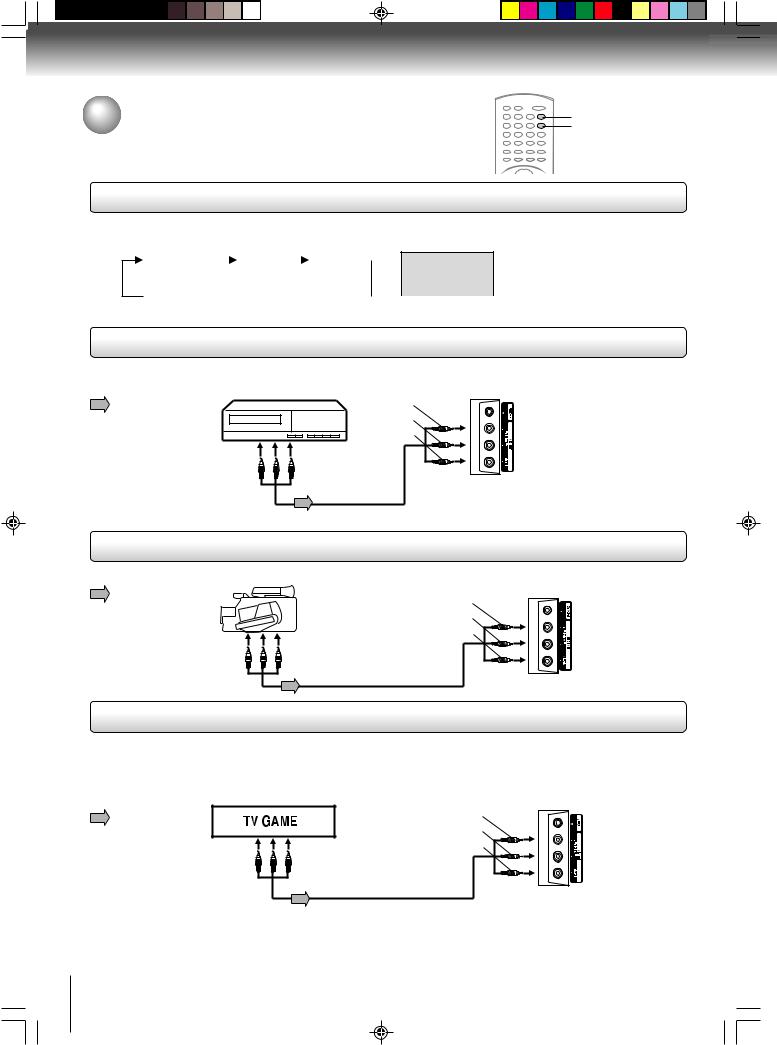
Connections
Connecting to optional equipment |
INPUT SELECT |
You can enjoy VCR, camcorder or TV game with connection to external |
GAME |
|
|
input. |
|
Using the audio/video inputs
Press INPUT SELECT repeatedly to select the desired mode.
“LINE1”, “LINE2”, “GAME”, “COMPONENT” or TV channel will display on the screen for 4 seconds.
TV Channel |
|
LINE 1 |
|
LINE 2 |
|
LINE 1 |
|
|
|
||||
|
(Rear lower left) |
(Left side) |
|
|||
COMPONENT  GAME (LINE 2 IN)
GAME (LINE 2 IN) 
Note: In the DVD mode this key will not operate.
Connecting to a VCR
Press INPUT SELECT to select the desired mode to use the TV as a monitor.
Operate your VCR as usual. |
VCR |
Left side |
: Signal flow |
|
(red) |
|
|
(white) |
|
|
(yellow) |
|
|
To Audio/Video OUT |
Audio/Video cable (not supplied)
Note: Picture might be muted for some VCR playback. This is not a malfunction of this unit.
Connecting to a camcorder
To playback from the camcorder, connect the camcorder to the TV/DVD as shown.
Left side
Camcorder (red)
(white) |
|
(yellow) |
|
To Audio/Video OUT |
|
Audio/Video cable (not supplied) |
To AUDIO(L/R)/VIDEO IN |
|
1.Connect a TV Game to the TV/DVD.
2.Press GAME. The GAME mode screen appears.
Left side
: Signal flow |
(red) |
|
(white) |
||
|
||
To Audio/Video OUT |
(yellow) |
|
|
Audio/Video cable (not supplied)
To AUDIO(L/R)/VIDEO IN
Notes:
•You can also change the TV screen to the desired mode by pressing the CH +/– buttons.
•The TV/DVD can also be used as a display device for many video games. However, due to the wide variety of different types of signal generated by these devices and subsequent hook-up variations required, they have not all been included in the suggested connection diagrams. You'll need to consult each component's Owner's Manual for additional information.
16
J5N00201A [E] (P14-25) |
16 |
6/8/04, 7:34 PM |
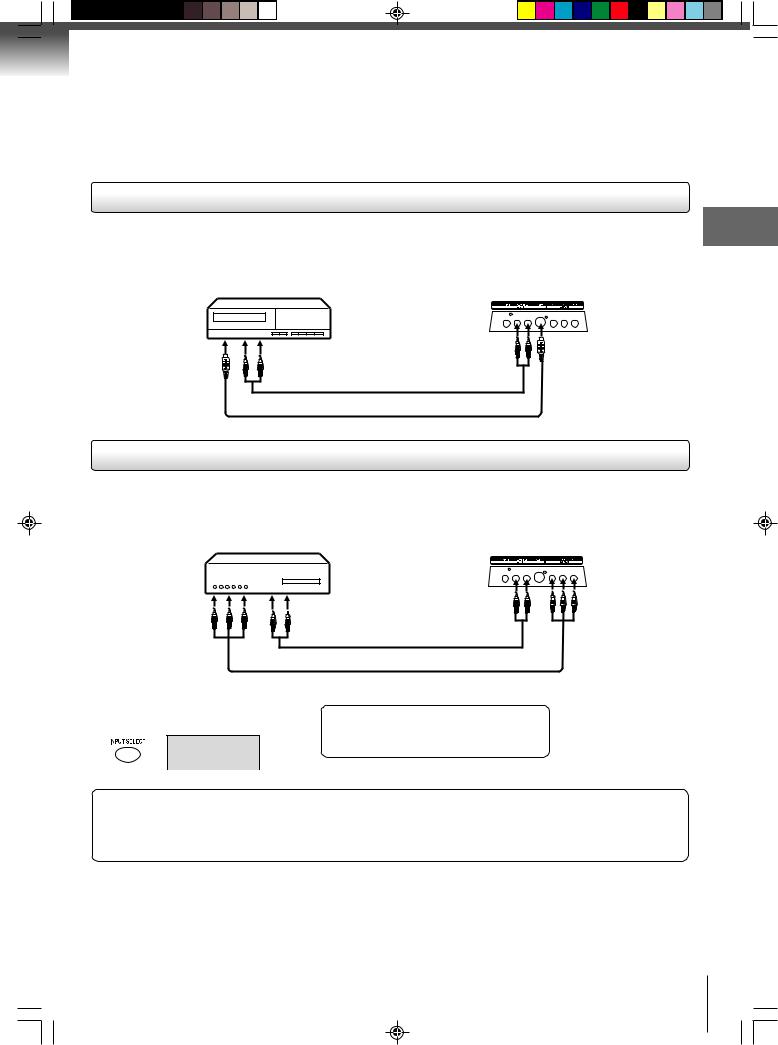
Connecting to an optional equipment with S-video output
If you connect a VCR with an S-VIDEO cable to the S-VIDEO IN jack on the rear lower left of the TV/DVD, you must also connect the audio cables to the AUDIO IN jacks on the rear lower left of the TV/DVD (LINE 1 IN). The S-VIDEO cable only carries the video signal. The audio signal is separate.
Note: When the S-VIDEO cable and the standard video cable are connected at the same time, the S-video cable takes precedence.
Ex. VCR with S-Video |
Rear lower left of TV/DVD |
||
|
|
||
|
|
To AUDIO (L/R) IN |
To S-VIDEO IN |
To S-VIDEO OUT |
To Audio (L/R) OUT |
|
|
Audio cable (not supplied)
S-Video cable (not supplied)
Connecting an optional equipment with ColorStream® (Component video) output
Connections
Your TV/DVD is capable of using ColorStream® (component video). Connecting your TV/DVD to a component video compatible DVD player, such as a Toshiba DVD player with ColorStream® can greatly enhance picture quality and performance.
Ex. DVD player with Component video |
Rear lower left of TV/DVD |
|||
|
|
|
||
|
|
|
To AUDIO (L/R) IN |
To COMPONENT |
To Component |
To Audio OUT |
|
(Y, PB/CB, PR/CR) IN |
|
Video OUT |
|
|
||
|
|
|
|
|
|
|
Audio cable (not supplied) |
|
|
|
|
Component video cable (not supplied) |
|
|
Selecting Component input mode |
|
|
|
|
Press INPUT SELECT repeatedly to |
When using the Component video cable, |
|
||
select “COMPONENT” mode. |
|
|
||
|
an Audio cable must be connected to |
|
||
|
|
|
||
COMPONENT |
|
AUDIO IN (L/R) (LINE 1 IN) jacks. |
|
|
The ColorStream® inputs on this unit are for use with devices that output 480i interlaced signals and 480p progressive signals. This unit will not accept or display 720p progressive scan signals or 1080i interlaced high-definition signals. If you connect a highdefinition set-top receiver, 720p progressive scan DVD player, or other similar device to the unit’s ColorStream® inputs, YOU MUST SWITCH THE DEVICE’S OUTPUT TO 480i INTERLACED OR 480p PROGRESSIVE MODE FIRST. Failure to do this will cause a poor or no picture to display.
Notes:
•Refer to the owner’s manual of the connected equipment as well.
•When you connect the unit to other equipment, be sure to turn off the power and unplug all of the equipment from the wall outlet before making any connections.
•If you place the unit near a tuner or radio, the radio broadcast sound might be distorted. In this case, place the unit away from the tuner and radio.
17
J5N00201A [E] (P14-25) |
17 |
6/8/04, 7:01 PM |
